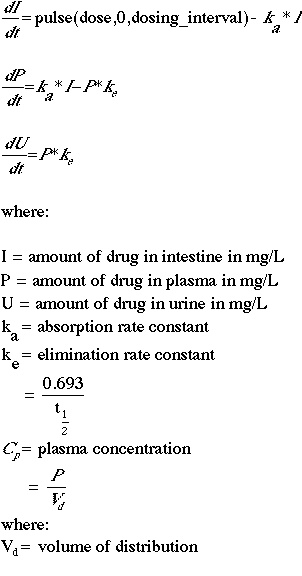Drug in the urine
The purpose of this model is to look at the effect of how a change in the amount of drug (the dose) and the dosing interval affects the amount of drug in the three compartments. We will want to try to stabilize the plasma concentration over a period of about eight days.
Building the Model:
In this model we are interested in the concentrations of drug in three-compartments, as described above. The algorithm for this particular model is outlined below. Using these algorithms and these initial values, your task is to build this model and then use it to investigate a number of scenarios, described in the section below.
Initial values:
Initial drug in the intestine = 0 mg/L
Initial drug in the plasma = 0 mg/L
Inital drug in the urine = 0 mg/L
Absorption rate constant (ka) = 1 /hour
Volume of distribution (Vd) = 70 L
Simulation time = 192 hours in 15 minute intervals (dt = 0.25 hour)
Using the Model:
Once you have completed your model, you should try a number of scenarios. What is the difference in changing the dosage and the dosing intervals? What settings might you use to reach a "threshold" dosage of 5.0 mg/L?
Algorithm Set for the Model:

Developed by
 The Shodor
Education Foundation, Inc.
The Shodor
Education Foundation, Inc.
Copyright © 2000-2003
Questions or comments about this page should be directed to biomed@shodor.org



 The Shodor
Education Foundation, Inc.
The Shodor
Education Foundation, Inc.